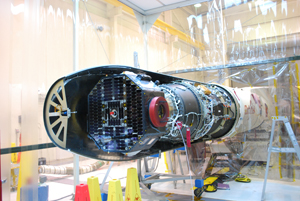Dave McComas

The launch of IBEX is just around the corner! As such, it seems fitting that the October 2008 Monthly Highlight interviewee be the leader of the project, the person who has seen it from its earliest concepts to the present day: Dave McComas, the Principal Investigator for the Interstellar Boundary Explorer mission.
Growing up in Milwaukee, Wisconsin among a father who was a lawyer and two of three siblings who also eventually chose the law as a profession, it would have seemed natural for Dave to also become a lawyer, but that wasn't "in the stars" for him. Dave has always been interested in science, and thought of himself as an inventor, constantly spending time building and trying, taking things apart, and putting them back together in new ways when he was young. "I found inventing to be really interesting when I was young because it allowed me to figure out how things worked and then use the parts in some new and unintended ways. As I grew older I zeroed in on physics as the key to unlocking the secrets of the Universe." Dave's parents encouraged him to be inquisitive, to be intellectual, and to learn about all sorts of things.
It was not an easy road for Dave to take while in school. He has dyslexia, a learning disability that manifests itself as difficulties with written words and letters. Because of this, Dave did not substantially learn to read until a fourth grade teacher worked hard with him to develop strategies to compensate for his reading problems. Thanks to this teacher, he did learn to read, and he has become an adequate reader (although still an inadequate speller) who has worked hard throughout his life to deal with his weakness in reading.
In high school, he decided that he wanted to study physics. While Dave was in college at the Massachusetts Institute of Technology, he worked at the MIT Center for Space Research as an undergraduate researcher in the laboratory, obtaining hands-on knowledge by helping graduate students and professors build instruments for a sounding rocket. He felt that this experience was an important step in his development as a scientist and is also something that he recommends to those who might want to be scientists. He says, "Get in the lab and do something. Get your hands dirty!"
After earning his bachelor's degree, Dave began working at the Los Alamos National Laboratory in the Space Group, allowing him to further his interest in space research. While there, he had the opportunity to work in what he says he can only describe as an "apprenticeship" with one of the great space experimentalists - Dr. Sam Bame. Dave was allowed to have his desk moved into Sam's lab, where he viewed and participated in all elements of the work with Sam designing and building space hardware. After two and a half years in the lab, Dave went to graduate school and earned his Ph.D. at the University of California at Los Angeles, where he studied space physics.
His involvement with the IBEX mission began in the earliest conceptual stages. He gathered the team of people with various skills who had the collective vision to write a proposal to NASA for a Small Explorer mission that would make remote measurements of the interaction between our Solar System and the Milky Way Galaxy. The ancestral lineage of Explorer missions at NASA goes back to the earliest days of the U.S. space program. There have been over eighty Explorer missions since 1958. Other well-known Explorer missions have included the Cosmic Background Explorer (COBE), the International Ultraviolet Explorer (IUE), and the venerable Explorer 1, the United States' first satellite. In 2005, NASA selected the IBEX mission for development.
About being a Principal Investigator, Dave says, "It's a really interesting job; it's a really challenging job. As P.I., I have overall responsibility for the entire mission. I touch every aspect of the mission: solving problems, addressing science issues, working with team leads, asking a lot of questions, and understanding as much as I can about the mission which involves hundreds of team members. I basically have my dream job!"
Currently, he is the Senior Executive Director for the Space Science and Engineering Division at the Southwest Research Institute in San Antonio, Texas. Dave has found that his job experiences over the years that have combined working with science data, designing and building new instruments, and managing large teams of people have served him well as P.I. of the IBEX team. When asked if he has recommendations for students or others who may want to be involved in space exploration, his advice is this: "You need to be broad. You need to be interested in science, engineering, and management of people, and work hard at developing some level of expertise across a lot of different areas so you can really be conversant and interact & lead a program. Overall, regardless of your field of interest, try your hardest all the time, see your dreams, and don't let difficulties get in your way. Think of them as challenges to overcome."
These days, when not dealing with the IBEX mission, Dave loves to spend time with his family, including three sons. Being with family is important to him, and one of his favorite things to do with his sons is elk hunting in the mountains of northern New Mexico, giving him a chance to unwind in the woods.
Right now, Dave is looking forward to the launch and hopes that everyone will be watching on October 19 and will exclaim, "GO IBEX!"
